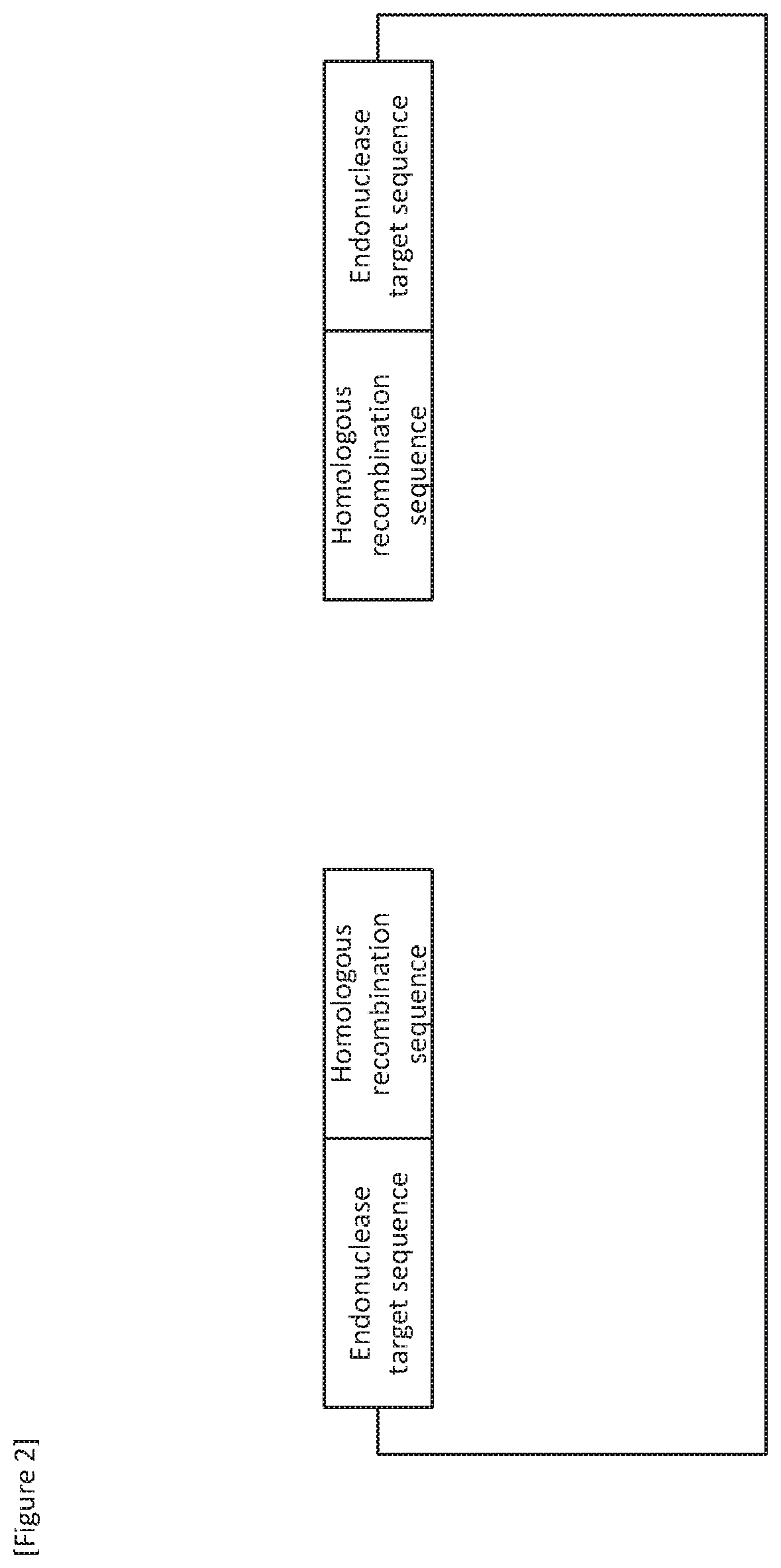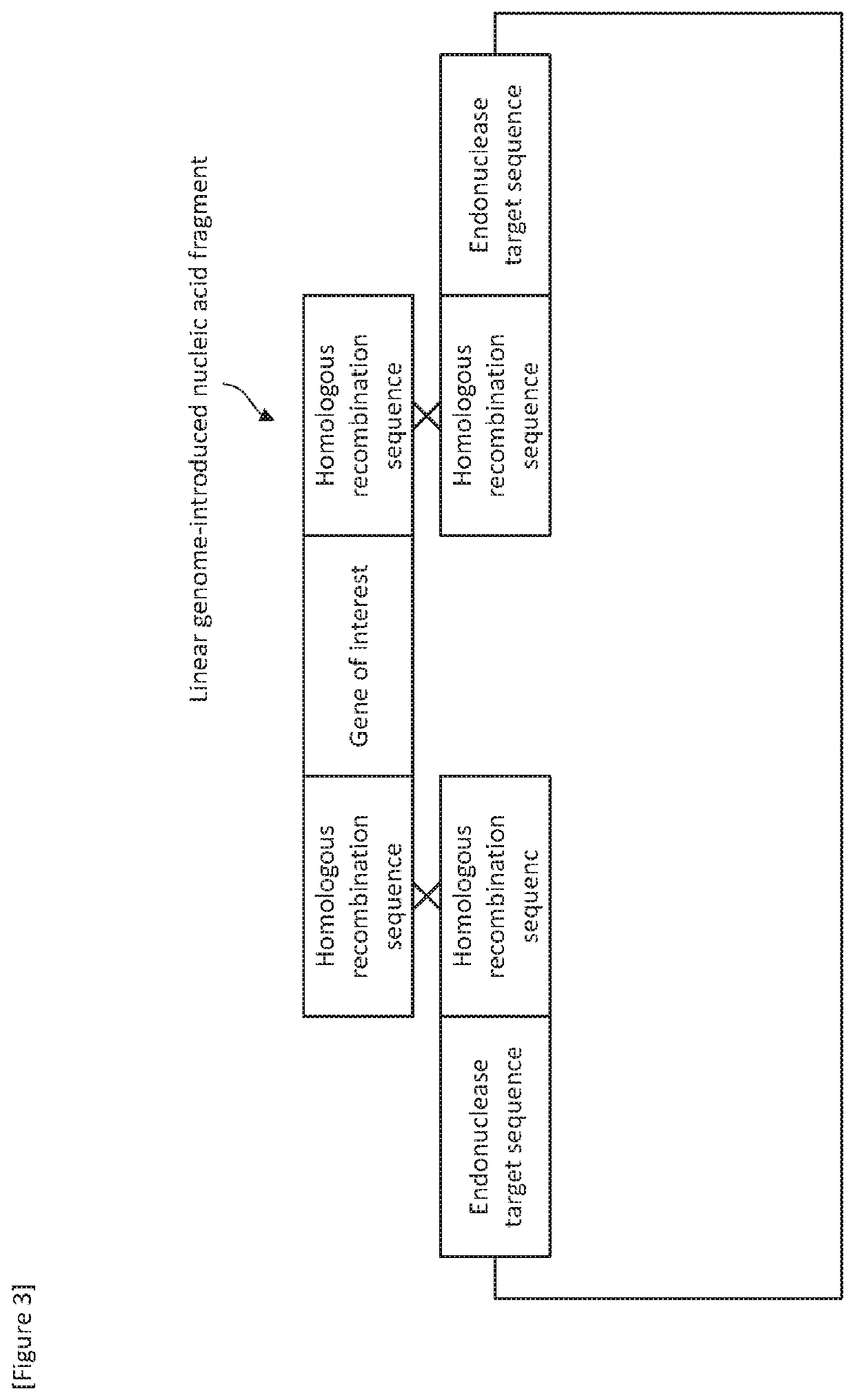Helper plasmid for transformation, method for producing transformant using the same, and transformation method
- Summary
- Abstract
- Description
- Claims
- Application Information
AI Technical Summary
Benefits of technology
Problems solved by technology
Method used
Image
Examples
first embodiment
[0035]Hereinafter, an embodiment in which a pair of endonuclease target sequences are disposed in a helper plasmid for transformation will be described. As shown in FIG. 2, the helper plasmid for transformation according to the present disclosure comprises a pair of homologous recombination sequences for incorporation of a linear genome-introduced nucleic acid fragment, and a pair of endonuclease target sequences disposed on the side opposite to the position into which the linear genome-introduced nucleic acid fragment is incorporated via the homologous recombination sequences. In other words, when the helper plasmid for transformation is cleaved at a position into which the above-described linear genome-introduced nucleic acid fragment is incorporated, so that it is converted to a linear plasmid, the linear plasmid has a pair of homologous recombination sequences at both ends thereof, and also has endonuclease target sequences following the respective homologous recombination seque...
second embodiment
[0065]Hereinafter, an embodiment in which a pair of endonuclease target sequences are disposed in a linear genome-introduced nucleic acid fragment comprising a gene of interest will be described. It is to be noted that, in the following explanation, the same terms as those used in the explanation regarding the first embodiment are used, so that detailed explanation regarding the configuration, etc. will be omitted.
[0066]In the second embodiment, as shown in FIG. 6, a linear genome-introduced nucleic acid fragment comprises a pair of first homologous recombination sequences capable of performing homologous recombination with a helper plasmid for transformation at both ends thereof, endonuclease target sequences inside of the first homologous recombination sequences, a pair of second homologous recombination sequences capable of performing homologous recombination with a host genome inside of the endonuclease target sequences, and a gene of interest inside of the pair of second homolo...
example 1
[0071]In the present example, a monoploid experimental yeast, S. cerevisiae BY4742, was used as a test yeast line.
[0072]The produced three types of vectors were: a YEp-type yeast shuttle vector pRS436(SAT)-P_GAL1-SCEI-T_CYC1-Sce-5U_ADE1-P_AgTEF1-G418-T_AgTEF1-3U_ADE1-Sce (see FIG. 9), comprising S. cerevisiae-derived homing endonuclease I-SceI (SCEI gene, NCBI Accession No. 854590) induced by galactose, and a sequence formed by inserting a DNA fragment containing a pair of homologous recombination sequences to be introduced into the genome between a pair of I-SceI target sequences (endonuclease target sequences); a YCp-type yeast shuttle vector pRS436cen(SAT)-P_GAL1-SCEI-T_CYC1-Sce-5U_ADE1-P_AgTEF1-G418-T_AgTEF1-3U_ADE1-Sce; and a YEp-type yeast shuttle vector pRS436(SAT)-P_GAL1-OnuIi-T_CYC1-Onu-5U_ADE1-P_AgTEF1-G418-T_AgTEF1-3U_ADE1-Onu, comprising Ophiostoma novo-ulmi subsp. americana-derived homing endonuclease I-OnuI gene (NCBI Accession No. AY275136.2) induced by galactose, and...
PUM
| Property | Measurement | Unit |
|---|---|---|
| Length | aaaaa | aaaaa |
Abstract
Description
Claims
Application Information
 Login to view more
Login to view more - R&D Engineer
- R&D Manager
- IP Professional
- Industry Leading Data Capabilities
- Powerful AI technology
- Patent DNA Extraction
Browse by: Latest US Patents, China's latest patents, Technical Efficacy Thesaurus, Application Domain, Technology Topic.
© 2024 PatSnap. All rights reserved.Legal|Privacy policy|Modern Slavery Act Transparency Statement|Sitemap



